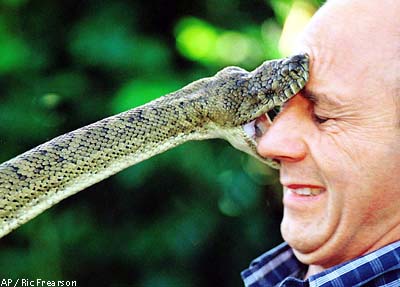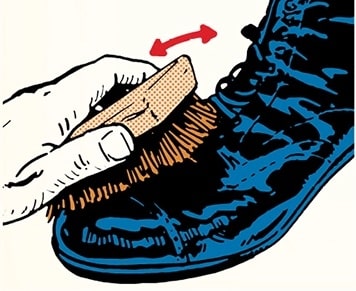
Yesterday, in Part 1 of the Art of Manliness’ Guide to Snakes, we discussed how to identify various poisonous serpents. But knowing your enemy is only half the battle. You should also know how to avoid being bitten and what to do if you are. Therefore, today in Part 2 we present more necessary man vs. snake knowledge: how to avoid and treat a snakebite.
How to Avoid a Snake Bite
While the behavior of snakes is obviously not 100% predictable, you can minimize your chances of being bitten by taking several basic precautions. If you want to avoid being at the receiving end of a pair of venomous fangs, follow these simple guidelines while out romping in the wilderness:
Avoid tall grass. Many of the snakes mentioned in Part 1 of this post like to hang out in grassy areas and heavy underbrush. If you can, stick to the trails so you can clearly see what you’re stepping on. If you have to go off trail, be attentive lest you inadvertently step on a sleeping rattlesnake. If you must venture through tall grass, carry a stick and use it to probe the ground in front of you. And remember, there are always exceptions to the rule; a snake could very well be curled up in the middle of a well groomed trail. Always be aware of your surroundings.
Remember that snakes can climb. While they’re not squirrels, snakes can slither up trees and bushes. Most people never imagine they’ll see a snake at eye level, and are thus quite vulnerable to an aerial attack. The last thing you want is to feel that forked tongue on your face, so keep your wits about you.
Check before you stick your hand into a crevasse. Because snakes are pure evil, they like to hang out in the dark. Holes, a hollow log, or a crevasse in a rock are perfect places for a snake to hide. So before you go sticking your hand in any dark hole, check to make sure there isn’t a snake (or another critter) in there.
Zombie snake attack. Say you find a dead snake that you want to take and turn into a pair of snakeskin boots. Right on. But be careful when picking it up. Freshly dead snakes still have reflexes and can still bite you if you’re not careful. I’ve seen a dead snake slither around firsthand. It’s really creepy. Plus, many snakes are pretty sloth-like during the daytime. And they’re quite skillful at keeping completely still; it’s how they catch their prey. So a snake sunning himself may look good and dead, but may very well be sleeping with one beady eye open, its little reptilian brain thinking, “Just try it buddy.”
Don’t sleep in the enemy’s lair. Most snakes are nocturnal, so you don’t want to let down your guard come sunset. Don’t make your camp in snake territory. Avoid sleeping near a log or large branch, in tall grass, or next to rocky areas. And of course zip up your tent tight. Snakes may have those fierce fangs, but alas, they lack an opposable thumb. Keep your boots inside the tent (most tents come with shoe pockets) and make sure to zip the tent up again in the morning, lest a snake invite himself in while you’re on a hike.
Wear heavy boots and pants. If you’re going to be out exploring in the uncivilized wilderness, make sure your lower extremities are protected. Heavy boots and pants not only protect against fierce snakes but also your ankle’s other nemesis-ticks.

Bonus Tip: Always Check The Overhead Compartment For Snakes
The Do’s and Don’ts of How to Treat a Snake Bite

No amount of precaution can prevent every bite. Sometimes accidents happen. And if it does happen, it’s important for you to immediately know what to do. Don’t be caught with a snakebite in the middle of the woods, scratching your head trying to remember this stuff; sear it into your brain. Getting bitten by a venomous snake is serious business. While the reactions vary from snake to snake, all venom is essentially designed to immobilize the victim and start the process of digestion. Venom is basically toxic snake saliva, ready to turn you into dinner. So if you’re bitten, seek medical attention immediately, even if you don’t think the snake is poisonous. Better to be safe than sorry.
Do:
1. Wash the bite with soap and water as soon as possible. You want to remove as much of the snake’s spit as you can.
2. Keep the bitten area below the heart. This is done to slow the flow of the venom.
3. Take off any rings or watches. The venom is going to make you swell, and jewelry might cut off your circulation.
4. Tightly wrap a bandage two to four inches above the bite. If you can’t reach medical care within 30 minutes, wrap a bandage around the bitten appendage. This is to assist in reducing the flow of venom. You want to make it tight, but not too tight as to completely cut off the appendage’s circulation. That will only cause tissue damage.
5. If you have a snake bite kit, place the suction device over the bite to help draw the venom out of the wound. Leave on for a maximum of ten minutes. If used properly, a suction device can remove up to 30% of the venom.
Interesting Fact: “Antivenin” is made by first milking a snake’s fangs for its venom and then injecting a non-lethal dose of that venin into a horse. The horse naturally builds up antibodies to the venom. Its blood is then collected and the antibodies are extracted and made into antivenin for humans. Cool.
Don’t:
1. Cut the wound. While watching an old Western, you might have seen a cowboy making an incision above the snakebite in order to “drain” the venom. This isn’t a smart move because you increase the chances of causing an infection in the area.
2. Suck the venom. Another remedy we all have seen in the movies is people sucking the venom out with their mouth. You don’t want the venom in your mouth where it can get back into your bloodstream.
3. Apply ice to the wound. Ice can cause tissue and skin damage and inhibits the removal of venom when using a suction device.
4. Panic. If you’ve been bitten, try to avoid freaking out. If you’re with someone who has been bitten, try to keep them calm. The more you move and the faster your heart beats, the quicker the venom is going to be circulated throughout your body. So do your best to stay calm and remain as still as humanely possible.






